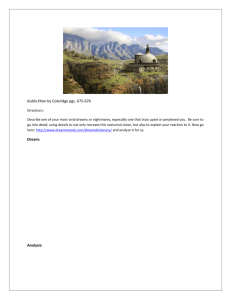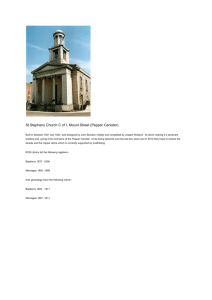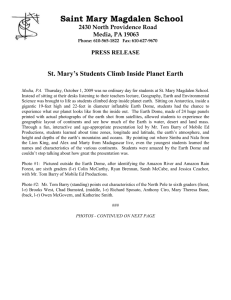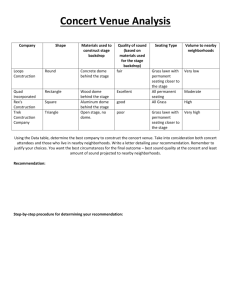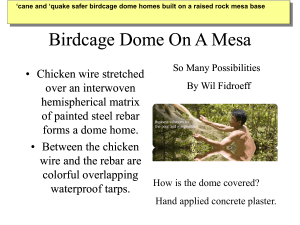T CASA SRL
advertisement
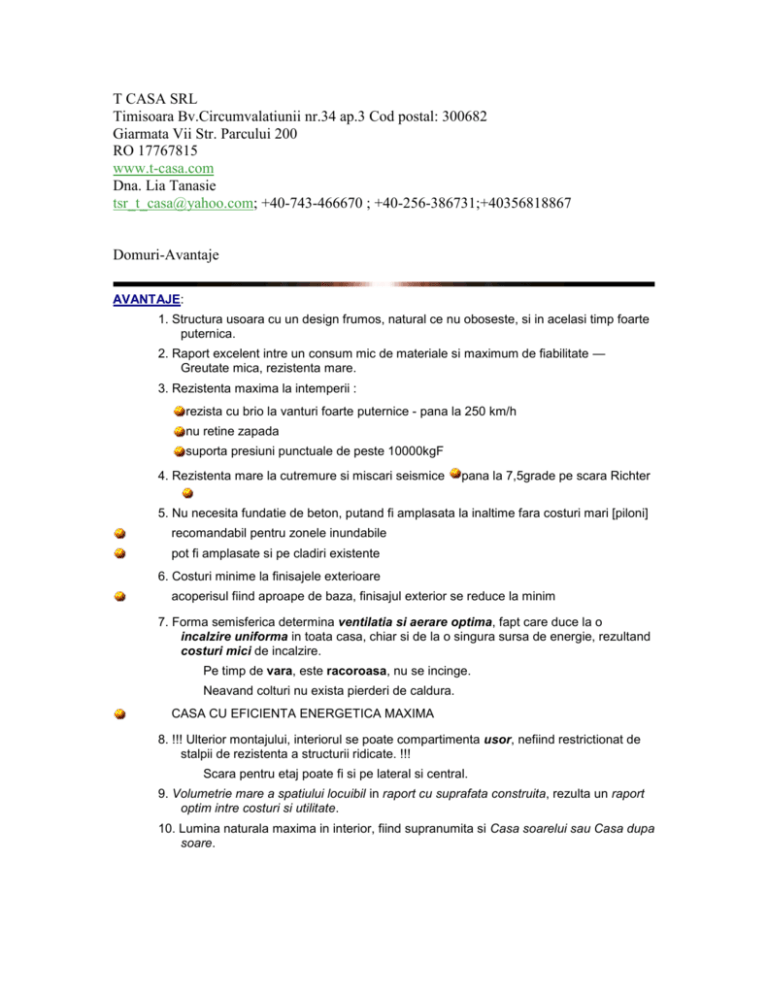
T CASA SRL Timisoara Bv.Circumvalatiunii nr.34 ap.3 Cod postal: 300682 Giarmata Vii Str. Parcului 200 RO 17767815 www.t-casa.com Dna. Lia Tanasie tsr_t_casa@yahoo.com; +40-743-466670 ; +40-256-386731;+40356818867 Domuri-Avantaje AVANTAJE: 1. Structura usoara cu un design frumos, natural ce nu oboseste, si in acelasi timp foarte puternica. 2. Raport excelent intre un consum mic de materiale si maximum de fiabilitate — Greutate mica, rezistenta mare. 3. Rezistenta maxima la intemperii : rezista cu brio la vanturi foarte puternice - pana la 250 km/h nu retine zapada suporta presiuni punctuale de peste 10000kgF 4. Rezistenta mare la cutremure si miscari seismice pana la 7,5grade pe scara Richter 5. Nu necesita fundatie de beton, putand fi amplasata la inaltime fara costuri mari [piloni] recomandabil pentru zonele inundabile pot fi amplasate si pe cladiri existente 6. Costuri minime la finisajele exterioare acoperisul fiind aproape de baza, finisajul exterior se reduce la minim 7. Forma semisferica determina ventilatia si aerare optima, fapt care duce la o incalzire uniforma in toata casa, chiar si de la o singura sursa de energie, rezultand costuri mici de incalzire. Pe timp de vara, este racoroasa, nu se incinge. Neavand colturi nu exista pierderi de caldura. CASA CU EFICIENTA ENERGETICA MAXIMA 8. !!! Ulterior montajului, interiorul se poate compartimenta usor, nefiind restrictionat de stalpii de rezistenta a structurii ridicate. !!! Scara pentru etaj poate fi si pe lateral si central. 9. Volumetrie mare a spatiului locuibil in raport cu suprafata construita, rezulta un raport optim intre costuri si utilitate. 10. Lumina naturala maxima in interior, fiind supranumita si Casa soarelui sau Casa dupa soare. CARACTERISTICI TEHNICE GENERALE T Casa srl produce si vinde kituri case standard care sunt practic seturi complete interior/exterior, dar fara compartimentare interioara completa si kituri case de baza care cuprind numai structura, panourile si setul de conectorii metalici super-locking 1. Domurile pe care le executam sunt de 8 tipuri SISTEM: 2. Grosimea finala a zidului exterior este de peste 45 cm, fiind mai mult decat suficient pentru un confort termic si fonic interior optim. Lemnul este tratat ignifug si fungicid, conform normelor europene. 3. Piesa centrala este sistemul de conectare metalic de forta: Super-Lok si Ultra-Lok Acesti conectori sunt proiectati sa fie asamblati usor, chiar si de amatori Sistemul de conectori metalici de forta este patentat in USA si verificati de peste 40 de ani. Fiecare connector singur poate prelua o tensiune de peste 30to, fiind din Otel dur cu insertie de titan, fiind placat anticoroziv cu un strat gros de zinc !!! Patentarea sistemului s-a facut si pentru Europa, deci inclusiv pentru Romania.!!! SC T CASA SRL este unic importator acreditat pe Europa de est. 4. Izolarea termica se face cu plapume fibra de sticla aglomerate de 40cm grosime, cu preaplicarea unui tampon anticondens 5. Izolarea impotriva intemperiilor se face cu sistemul Tegola Canadesse, in care se foloseste folia Ice-Bar si Alu-Bar pentru etansarea exterioara si interioara., dar in acelasi timp pentru a permite casei sa respire. 6. Dupa izolare rezulta un Factor R [Termic] de peste 65 7. Cupola este recomandata domurilor cu diametru mai mare de 7m. Poate fi un loc de relaxare de unde sa aveti o priveliste deosebita. Asigura circulatia optima a aerului din interior 8. Intrarea este in forma de pentagon ascutit cu usa in mijloc, dar la cerere se poate executa si alta forma. Spatiul deasupra usii se poate folosi ca terasa. English version Super-Lok Patented Dome Building System. (TM) At the heart of the Natural Spaces Domes System is our patented connection hardware which we call the Super-Lok. Invented in1978, it was the answer to six years of dome building using inadequate wood plates, metal brackets and panelized systems. The sleeve is made from very heavy gauge steel with an extra thick zinc plating to make it rust proof. What we were looking for was a connector that was self aligning and so simple to put together that any dummy- sorry, that should be any "novice" dome builder could do it. We didn't want you to have to do any of the assembly of the strut hardware up on the scaffolding. With our system all you do is slip the sleeve tongue into the hub slot and pound a hardened, 4 inch plated bolt "pin" in place, securely locking the two together. That's it. No coming back to tighten, no re-aligning, no adjusting. The next step is just moving on to the next strut. Working with our structural engineer and our metal fabricator, we came up with our unique hub design. The entire hub is a one piece, very high strength, aluminum extrusion. The tongue from the sleeve fits into the slot in the middle of the hub. Having squashed various pipe hubs during testing, we came up with integral reinforcing spokes to strengthen the hub. It now could take extreme pressure from the struts - both pulling and pushing. The heavy plating on the steel sleeve prevents any galvanic reaction with the aluminum hub. For sea coast applications, we provide a special sulfuric anodized coating on the aluminum hub, preventing any deterioration from salt in the air. We then coat the steel sleeves with a special epoxy coating (similar to that found on running boards of vans) eliminating any potential for rust. Our Natural Spaces connector system is the strongest dome home connector on the market. Our competitors have been heard to say our system is over engineered - we think you deserve nothing less. Super-Wal The Double Strut System Most other dome companies offer 2x4 struts as standard or at best 2x6 as standard. Very few will even offer 2x8 as an option. Why? Probably because it's easy and cheap. For them, that is. We learned (several hundred domes ago) that a 2x6 dome is not enough. When Natural Spaces was formed in 1978, we had learned from six years of dome building and the energy crisis that old building methods were not going to carry us into the 21st Century. So, we invented the Super-Wal double strut system providing a true super insulated dome system. We learned how to manufacture a 15", 18" or 21" wide strut for the same price as our 2x10 strut. We learned how to produce and sell them for less money than our competitors 2x6 dome system. Why do you need such a thick strut? To add more insulation and provide for wall cavity air ventilation. Is there a maximum "R" value or a point of diminishing returns? The additional investment you are making in the Super-Wal is so small that you a get a fantastic return. If anyone can predict what the world energy picture will be like 10, 25 or 50 years from now, we'll tell you exactly what the pay back is. Just think back 20 years ago. Now, don't you want something more than a 2x6 dome? We also made our Super-Wal system easy to erect. Being pre-assembled, you don't have to go back and add anything or tighten or align anything. Once you pound the bolt in place, your framework is locked rigidly together. You erect your double-strut dome framework in one day in one operation. 49' mid profile - Brainerd, Minnesota (small 20' dome - to be covered with concrete and buried under dirt) Because we use safe, economical fiberglass batt insulation, we have developed standard SuperWal sizes: Super-Wal Insulation Air space R-value 15" 6 1/4" & 6 1/4" 2 1/2" 44 18" 8" & 8" 2" 55 21" 9 1/2" & 9 1/2" 2" 66 Two 6" batts are cheaper than one 12" batt. We notch our struts and set back our sleeve to allow airflow between panels. Our Super-Wal double strut system is not a new, experimental system. We've been building it for years. It's practical and economical to build. Best of all, it will save you thousands of dollars in your future fuel bills, providing you comfort of mind and body. Ventilation Wall Cavity As leaders and pioneers in the field of dome home technology, Natural Spaces has developed a dome wall ventilation system that provides for continuous natural air circulation over the entire fiberglass insulation surface. Air enters at the bottom of the dome shell through a flared base vent skirt with screening, rises as it is warmed by the sun, and escapes out of the top low profile vent cupola. The air being vented carries with it any moisture-laden air that has migrated into the wall cavity from the inside of the dome. Most other dome companies ignore the condensation problem or simply don't know it exists. Almost all of the building codes call for a vented air space on the cold side of the fiberglass insulation in any cathedral ceiling. All building codes require ventilation of attic spaces. Dome companies that use rigid insulation, cutting it to fit within the triangles, may have a serious condensation problem because the insulation board does not fit tight to the outside panel. This leaves a perfect space for vapor to condense on the outside panel. (This holds true except for coastal areas and the far south.) The only kind of insulation not subject to this problem is sprayed in place urethane. This material, when properly applied to dry wood, does not allow vapor to penetrate. However, there are other problem details to be dealt with correctly. Urethane is also much more expensive than fiberglass. Talk to us, after 25 years of building them, we know domes. We live in Minnesota with a 150 degree temperature variation--we know weather. Our ultra-insulated dome system works in cold climates as well as hot climates. Building a warm dome doesn't just mean more insulation. It's many things, like our vented dome shell, insulation placement, caulking details, Tyvek® Housewrap, 6 mil plastic vapor barrier, foundation wall insulation, triple and four pane windows, internal heat re-circulation, and other items. Our warm dome is economical to build. We don't want you sitting in your warm dome worrying about how you are going to pay the mortgage. We want you sitting in your warm Natural Spaces dome chuckling about your neighbor in his cold, conventional, expensive house. Condensation Condensation can be described as the change in moisture from a vapor to a liquid. water vapor within the house can migrate through the wall or ceiling during the heating season to some cold surface where it condenses, collecting in the form of ice or frost. During warm or sunny periods, the frost melts. When conditions are severe, this meltdown in unvented spaces may drip to the ceiling below and damage the interior finish. Wood sheathing may swell up. Insulation becomes wet and looses it's resistance to heat loss. These problems can be reduced or eliminated when proper construction details are used. The control of condensation through the use of vapor barriers and ventilation should be practiced regardless of the amount of insulation used. The use of both inlet and outlet vents in attic and roof spaces aids in keeping the air moving and preventing the accumulation of frost or condensation roof sheathing in cold areas. "Dead" air pockets in the roof can normally be prevented by good distribution of inlet vents in the soffit areas. However, there is still a need for vapor barriers; ventilation alone, when insulation is used, does not prevent condensation problems.
